Guerrilla ammunition. 1 part
Trophy German cartridges, namely - rifle 7,92x57-mm "Mauser" and pistol 9x19-mm "Parabellum" - adapted to rework for shooting from domestic small arms: the first - for Mosin and SVT, as well as machine gun DP; the second is for 7,62-mm PPSh and PPD submachine guns, TT pistol. The figure (above) shows the “heroes” of this amazing story in pairs. More precisely, regular domestic and German cartridges with indication of their main sizes. Domestic left, German right.
Even the first, inexperienced look at these cartridges says that the task of converting some cartridges into others, to put it mildly, looks more like an adventure than a real technical project. Let's try to figure it out.
The information that was available until recently on this issue was fragmented, incomplete and did not give clear answers to all questions.
The Journal “Weapon”, No. 6 for 2001 the year was published an interesting article by Pavel Stolyarov “Partisan Press. Crazy hands: alteration of cartridges in the field. "
In November 2012 of the year user Christopher Reed (kris_reid) posted on his blog in livejournal note, presenting for the first time to the public the materials on this topic found in the archives - Act on test results in April 1943 of the converted German pistol and rifle cartridges, as well as a later Report on the tests of the same cartridges in May 1943 on the Scientific Research Field of Red Armament Army (NPSVO KA) in Moscow, Shurovo.
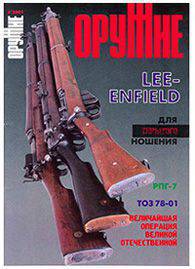
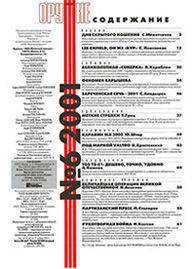
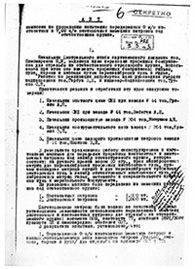
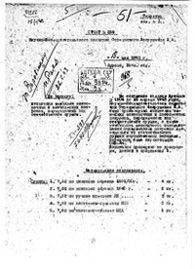

The last, missing “brick” today was a separate chapter devoted to this topic in the first book of a four-volume monograph "Small arms ammunition"published in 2015 year.
The author of the monograph, Vladislav Nikolaevich Dvoryaninov, from the end of 1982, worked as head of the leading cartridge department at TsNIITOCHMASH in the USSR and in Russia, replacing Boris Vladimirovich Semin, who was a direct participant in those events.
A curious document was discovered in his personal archive - "Manual to rifle manual press for alteration of captured cartridges for domestic weapons", issued by the printing house of the publishing house “Sovetskaya Belarus” in the number of 500 copies, the content of which became the basis of the material for the chapter in the book.
So, 1942-43 year. There is a war. In the occupied territories there are numerous guerrilla groups. At first, spontaneously and separately, but by this time it was already much more organized and coordinated. For the operational and clear leadership of the partisan formations, providing them with all kinds of assistance and supplies, in May 1942, the Central Headquarters of the partisan movement (TSPHD) was created. He was headed by the first secretary of the Central Committee of the Communist Party (Bolsheviks) of Belarus Panteleimon Kondratievich Ponomarenko.
Among other things, one of the main tasks of the headquarters was to provide the partisans with everything necessary for conducting combat operations. First of all - weapons and ammunition. It is well known from history that the partisans experienced real and objective difficulties in this. Only today, from afar, arguing "sensibly" and theoretically, you can easily send fighters "to get yourself weapons and ammunition from the enemy." Of course, the guerrillas always and at all times extracted trophies and successfully used them. But before judging the best supply routes, you need to be aware of the real need for cartridges and the real possibilities to get serviceable weapon for them in the required amount.
Weapons always and in all armies were supposed to be assembled on the battlefield, the loss of military weapons was the most serious offense for which they were severely punished. For example, in the German army, even for the loss of a spare barrel to the machine gun relied shooting. Therefore, they were worn in special cases with shoulder straps, over the shoulder. On the other hand, due to the huge consumption of cartridges, they were supplied in colossal quantities. For example, only for the 50 days of the Battle of Kursk our troops spent half a billion rifle and machine guns (more precisely - pistol) cartridges! Expenses of the German army were appropriate. Therefore, to obtain captured ammunition was much more real than weapons. Both mined and reported about it in the center ...
As follows from the archival documents, personally head TSSHPD Ponomarenko "Put forward the idea of reworking captured ammunition for firing from domestic small arms, using all the elements of captured ammunition: sleeves, bullets, gunpowder and capsule by pereobzhatiya bullets and sleeves", “The work on the realization of the proposed idea was led by the guard lieutenant colonel comrade. Garbuz V.I. and lieutenant colonel comrade. Trusov S.K. ”.
The development of technology and practical implementation was carried out at the Moscow Plant No. 44 in Maryina Roshcha (a branch of the Plant No. 46 in Kuntsevo). More precisely, in the newly separated from it in 1943, an independent cartridge OKB-44. The workshop also involved the gross production of cartridges directly from plant number XXUMX and plant number XXUMX.
The idea of our patrons, at its core, was simple and original.
German rifle cartridge pereobzhat so that it is fixed in the chamber of domestic weapons with the slope of the sleeve, and not with a hat-edge, like our regular cartridge 7,62х54 R. Cut off the excess sleeve. Bullet pereobzhat under our caliber, use trophy powder.
In the 2, the blue lines show the fixing points for the cartridges of both cartridges in the Mosin rifle chamber. On the left - our regular rifle cartridge. It is fixed by a protrusion at the bottom of the sleeve - called a cap or rim. In the center - how would a regular German rifle cartridge be located. In this sketch, an error was made - the diameter of the German bullet is larger than the diameter of the bullet entrance in the Mosin rifle chamber. But some experts say that shooting German 7,92x57-mm cartridges out of it was “possible and so” without reworking ... It is clear that even if you “hammer the cartridge all the way”, it will rest on the side of the cartridge and will be much longer than ours, protruding outside and not letting the shutter close. On the right is a converted trophy cartridge and, also with blue lines, a method of its fixation.
The German pistol cartridge and cartridge case are also pereobzhat, but "with a twist": on the converted bullet to organize a leading belt that will imitate the slope of the cartridge case of our cartridge and fix it in the chamber of the national weapon, as shown in figure 3. Also use a slightly overplashed original sleeve with a primer and trophy powder.
To implement these ideas, use an elementary manual press with enough effort, a set of dies and punches. Plus adapt for raspratirovaniya and the subsequent assembly of converted cartridges. In principle - everything is realistic to implement, including in a partisan detachment.
Invented, done, tested.
In April, 1943, apparently, took place the first real tests of the proposed method and shot out the 1000 converted cartridges with it. The act of the commission, signed by all the “main” leaders and executives, was very positive. It noted the reliability of the weapon, the normal initial velocity of the bullets, good accuracy and penetrability, the correct pressure of powder gases. For pistol cartridges it was noted that “It is desirable to reduce the rate of fire by reducing the charge, because with a high rate of fire detected on 500 shots 15 cases of jamming of the sleeves between the gate and the breech ”.
And the findings of the commission: “Based on the test results, the commission considers: it is quite possible for partisans to rework on the ground of captured pistol and rifle cartridges for firing from automatic PCA, TT and 1891 / 30 model rifles. To solve the problem of the possibility of firing a machine gun DP and SVT rifle, conduct additional tests ".
Developers, judging by the dates of archival documents, very quickly made improvements and improvements in these areas, produced and submitted for testing 4200 rifle pieces and 2000 pistol converted cartridges. The tests were carried out at the Spacecraft Research Institute, in Shchurovo, Moscow Region, in the beginning of May 1943.
Following the test, 18 May 1943, the report was released test site "On the issue of testing the German rifle and pistol cartridges, converted to domestic weapons. Based on the task of Artkom No. 1204 from April 23 of 1943 of the Year, KA Scientific Research Firing Range. ” Which read without tears is impossible. Apparently, few people expected such a failure and the number of problems identified during testing ... If only this report were available to us today, then it would be difficult to call such an alteration as drama and adventure.
What turned out during these tests?
At first, external inspection of the converted cartridges revealed that they were made poorly - an unacceptably large number of pistol cartridges with cracks on the bullets and sleeves, poorly fixed bullets and removed by hand force; rifle cartridges are poorly crimped in Dultz, slope sleeves of irregular shape; in size, those and others sharply diverge from the drawings.
Secondly, the initial velocity of the bullets and the pressure of the powder gases in both converted pistol and rifle cartridges are significantly lower than our standard cartridges and the requirements of domestic technical specifications.
Thirdly, the number of delays in the test shooting automatic rifle Tokarev arr. The 1940 of the year was 100% for a sample of medium depreciation and 39,7% for unworn. Degtyaryov DP machine gun "Absolutely did not give automatic fire". When firing a pistol TT revealed up to 14,3% delays.
Fourthlywhen tested by Mosin rifle shooting arr. 1891 / 30: very tight shutter closure was detected, from 20 to 50% of cases; tight extraction of spent cartridges and the need to use a cleaning rod to knock them out of the chamber (in 3% of cases); misfires when shooting from a worn rifle to 20%; "The sticking of the cartridge and the non-reflection of the spent cartridges, which has come down in one medium-sized rifle to 34,4% in total".
Fifthly, provided for the replacement of staff, extractors for CBT and DP “Made carelessly, do not meet the requirements of the drawings ... two rifle extractors (out of three) and one extractor for a DP machine gun (out of two) broke down during firing”.
However, the report also noted positive test results:
- the strength of the bullet casings and the penetrating ability of bullets of pistol cartridges are satisfactory. Penetration of 3 rows of 25 mm boards is provided. Accuracy is satisfactory;
- shooting for the reliability of the PPSh and PPD submachine guns was satisfactory;
- pistol bullets were caught in tow, their girdle disappeared, the bullets were of the correct shape, with the exception of the back, where they were smaller in diameter than the leading part and the back was somewhat deformed.
But these “advantages” were clearly not enough to recognize the test results as positive, therefore the conclusions and conclusion in the report were devastating.
"Findings [polygon]:
1. German pistol cartridges, converted by OKB-44 into domestic weapons, are unsuitable for firing from TT pistols, but can be used for firing from submachine guns, with an improvement in the conversion method, as indicated in paragraph 2. Accuracy and penetrating action are satisfactory.
3. The German rifle cartridges converted by OKB-44 to fit our weapons, in the form in which they were sent to the NIPSVO KA, are unsuitable for firing either from a rifle of the 1891/30 and 1940 model (especially the latter), or from a DP light machine gun. At the same time, it was found that the more worn out the weapon (still remaining within military tolerances), the more delays in firing give converted cartridges..
“Conclusion [polygon].
1. The method of converting German pistol cartridges, developed by OKB-44, is in principle correct, and after refinement in the direction indicated in this report, it can be recommended to partisan detachments.
2. The method of converting German rifle cartridges, developed by OKB-44, is unsuitable, since the converted cartridges are not suitable for firing from domestic weapons.
3. It should be proposed to OKB-44 to develop a new method for converting captured rifle cartridges, taking into account all the shortcomings identified by testing at the NIPSVO KA and the wishes of the latter and a new batch of such cartridges to be sent to the NIPSVO for secondary testing.
4. NIPSVO KA generally believes that such, albeit improved, reworking of pistol and rifle cartridges justifies itself only in the absence of appropriate captured weapons ".
That's it - no one needs such alteration ...
It should be noted here that the “Scientific Research Field of the Red Army Rifle Armament” - the NPSVLA spacecraft in Shchurovo was in those years one of the most authoritative centers of the USSR in terms of research, development and testing of small arms and ammunition systems. Experienced and technically competent military engineers of the landfill knew a lot about their business and enjoyed well-deserved authority. And OKB-44 at the cartridge factory No.44 was just created and by that time did not recommend itself. So it was possible to “pass the test” from the first time only with ideal results. Although the objectivity of the conclusion and the validity of the findings of the landfill on the test results are absolutely obvious.
What's next? Since no one canceled the task of developing such a method, the idea belonged personally to the chief of the Central Headquarters of the partisan movement, and the need for such alteration was obvious, the work had to continue. And they continued.
Продолжение следует ...

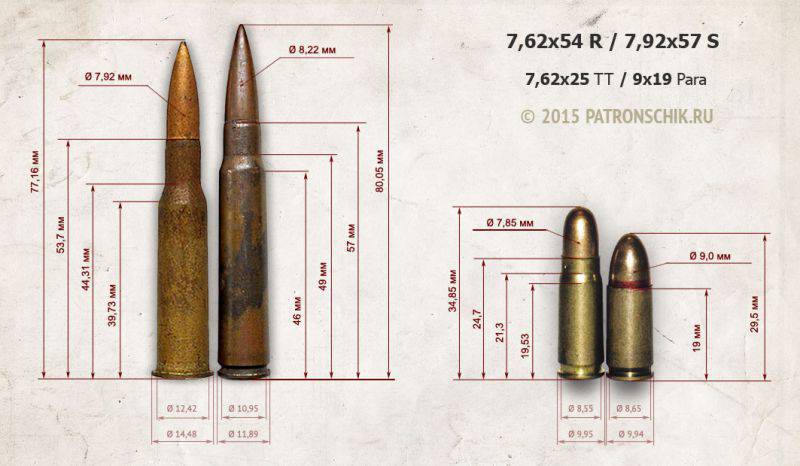
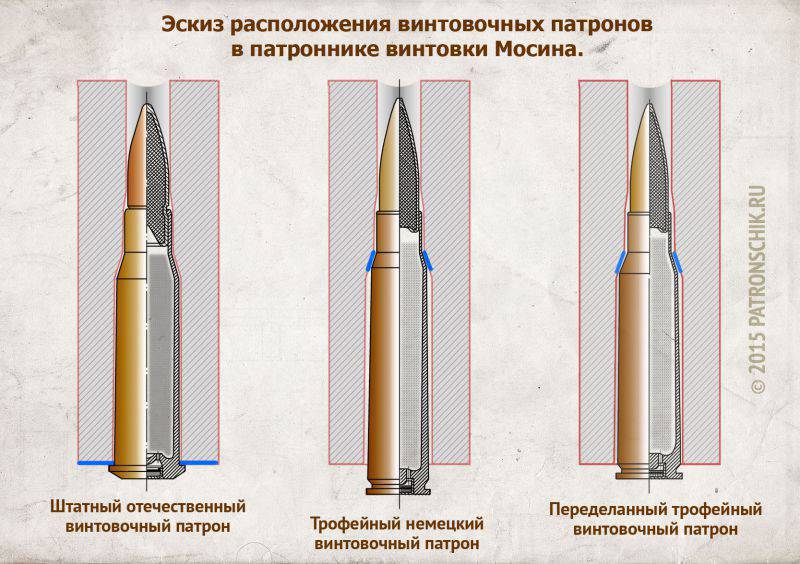
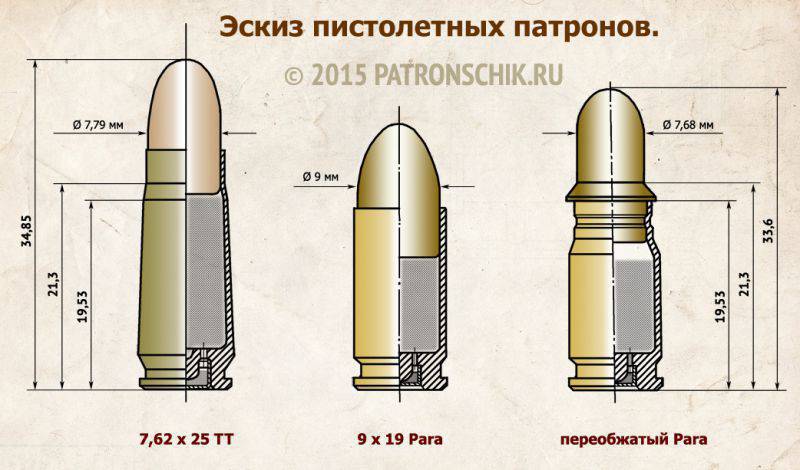
Information